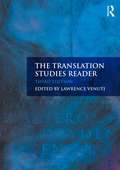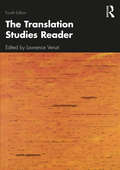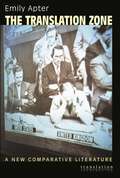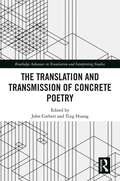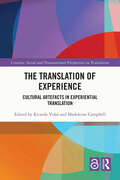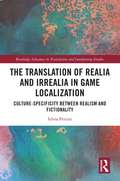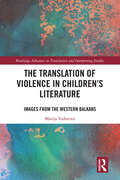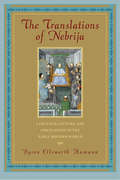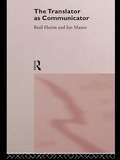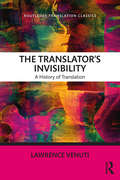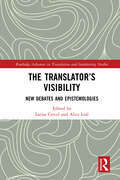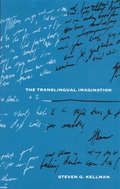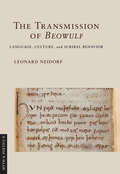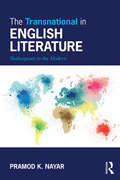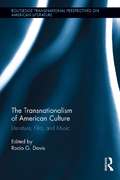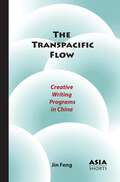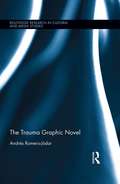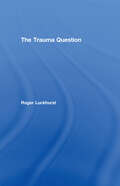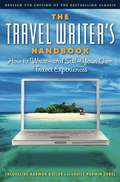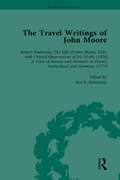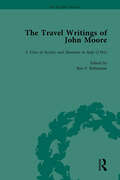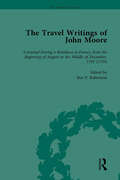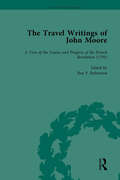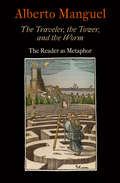- Table View
- List View
The Translation Studies Reader
by Lawrence VenutiThe Translation Studies Reader provides a definitive survey of the most important and influential developments in translation theory and research, with an emphasis on twentieth-century developments. With introductory essays prefacing each section, the book places a wide range of seminal and innovative readings within their thematic, cultural and historical contexts. The third edition of this classic reader has been fully revised and updated and adds a new section: 2000 and beyond , which includes five new readings. These new readings bring the Reader up to date with recent developments in the field and include articles on translation and world literature and translation and the internet.
The Translation Studies Reader
by Lawrence VenutiThe Translation Studies Reader provides a definitive survey of the most important and influential developments in translation theory and research, with an emphasis on the twentieth and twenty-first centuries. The introductory essays prefacing each section place a wide range of seminal and innovative readings within their various contexts, thematic and cultural, institutional and historical. The fourth edition of this classic reader has been substantially revised and updated. Notable features include: Four new readings that sketch the history of Chinese translation from antiquity to the early twentieth century Four new readings that sample key trends in translation research since 2000 Incisive commentary on topics of current debate in the field such as world literature, migration and translingualism, and translation history A conceptual organization that illuminates the main models of translation theory and practice, whether instrumental or hermeneutic This carefully curated selection of key works, by leading scholar and translation theorist, Lawrence Venuti, is essential reading for students and scholars on courses such as the History of Translation Studies, Translation Theory, and Trends in Translation Studies.
The Translation Zone: A New Comparative Literature (Translation/Transnation #16)
by Emily ApterTranslation, before 9/11, was deemed primarily an instrument of international relations, business, education, and culture. Today it seems, more than ever, a matter of war and peace. In The Translation Zone, Emily Apter argues that the field of translation studies, habitually confined to a framework of linguistic fidelity to an original, is ripe for expansion as the basis for a new comparative literature. Organized around a series of propositions that range from the idea that nothing is translatable to the idea that everything is translatable, The Translation Zone examines the vital role of translation studies in the "invention" of comparative literature as a discipline. Apter emphasizes "language wars" (including the role of mistranslation in the art of war), linguistic incommensurability in translation studies, the tension between textual and cultural translation, the role of translation in shaping a global literary canon, the resistance to Anglophone dominance, and the impact of translation technologies on the very notion of how translation is defined. The book speaks to a range of disciplines and spans the globe. Ultimately, The Translation Zone maintains that a new comparative literature must take stock of the political impact of translation technologies on the definition of foreign or symbolic languages in the humanities, while recognizing the complexity of language politics in a world at once more monolingual and more multilingual.
The Translation and Transmission of Concrete Poetry: Translation and Transmission (Routledge Advances in Translation and Interpreting Studies)
by John Corbett Ting HuangThis volume addresses the global reception of "untranslatable" concrete poetry. Featuring contributions from an international group of literary and translation scholars and practitioners, working across a variety of languages, the book views the development of the international concrete poetry movement through the lens of "transcreation", that is, the informed, creative response to the translation of playful, enigmatic, visual texts. Contributions range in subject matter from ancient Greek and Chinese pattern poems to modernist concrete poems from the Americas, Europe and Asia. This challenging body of experimental work offers creative challenges and opportunities to literary translators and unique pleasures to the sympathetic reader. Highlighting the ways in which literary influence is mapped across languages and borders, this volume will be of interest to students and scholars of experimental poetry, translation studies and comparative literature.
The Translation of Experience: Cultural Artefacts in Experiential Translation (Creative, Social and Transnational Perspectives on Translation)
by Ricarda Vidal Madeleine CampbellExperience is a multilayered, cumulative affair with transformation at its core. Its study, a necessary first step for its translation, requires an exploration of embodiment, the senses, and cultural and social environments.The second of two volumes, this book explores how artefacts, as outcomes of experience brought about by the “artistranslator” perform semiotic work. This semiotic work arises through the intervention of their makers but also through their viewers/audience, often through the latter’s direct participation in the artefacts’ creation, which we see as an open-ended process. Drawing on diverse examples from across the world, the chapters explore visual materiality, the digital world and the multisensory nature of artefacts such as monuments, festivals, theatre performances, artworks, rituals, the urban environment and human bodies—the embodied perception of which may draw holistically or variously on the haptic, olfactory, auditory, kinetic or kinaesthetic senses. Throughout the book, experiential translation is framed as a political endeavour that allows experience to be shared across linguistic, cultural, generational or gendered divides in the form of artefacts that facilitate transformation and the acquisition of knowledge.This book and its companion volume The Experience of Translation: Materiality and Play in Experiential Translation include an international range of contributions from graduate students and early career researchers (ECRs) to tenured academics in translation studies, comparative literature, performance arts, fine arts, media and cultural studies, as well as educators, artists and curators. It will be of particular interest to translators and arts practitioners, scholars and researchers in the transdisciplinary field of humanities.
The Translation of Realia and Irrealia in Game Localization: Culture-Specificity between Realism and Fictionality (Routledge Advances in Translation and Interpreting Studies)
by Silvia PettiniThis book explores the impact of a video game’s degree of realism or fictionality on its linguistic dimensions, investigating the challenges and strategies for translating realia and irrealia, the interface of the real world and the game world where culture-specificity manifests itself. The volume outlines the key elements in the translation of video games, such as textual non-linearity, multitextuality, and playability, and introduces the theoretical framework used to determine a game’s respective degree of realism or fictionality. Pettini applies an interdisciplinary approach drawing on video game research and Descriptive Translation Studies to the linguistic and translational analysis of in-game dialogs in English-Italian and English-Spanish language pairs from a corpus of three war video games. This approach allows for an in-depth look at the localization challenges posed by the varying degree of realism and fictionality across video games and the different strategies translators employ in response to these challenges. A final chapter offers a comparative analysis of the three games and subsequently avenues for further research on the role of culture-specificity in game localization. This book is key reading for students and scholars interested in game localization, audiovisual translation studies, and video game research.
The Translation of Violence in Children’s Literature: Images from the Western Balkans (Routledge Advances in Translation and Interpreting Studies)
by Marija TodorovaConsidering children’s literature as a powerful repository for creating and proliferating cultural and national identities, this monograph is the first academic study of children’s literature in translation from the Western Balkans. Marija Todorova looks at a broad range of children’s literature, from fiction to creative non-fiction and picture books, across five different countries in the Western Balkans, with each chapter including detailed textual and visual analysis through the predominant lens of violence. These chapters raise questions around who initiates and effectuates the selection of children’s literature from the Western Balkans for translation into English, and interrogate the role of different stakeholders, such as translators, publishers and cultural institutions in the representation and construction of these countries in translated children’s literature, both in text and visually. Given the combination of this study’s interdisciplinary nature and Todorova’s detailed analysis, this book will prove to be an essential resource for professional translators, researchers and students in courses in translation studies, children’s literature or area studies, especially that of countries in the Western Balkans. .
The Translations of Nebrija: Language, Culture, and Circulation in the Early Modern World
by Byron Ellsworth HamannIn 1495, the Spanish humanist Antonio de Nebrija published a Spanish-to-Latin dictionary that became a best seller. Over the next century it was revised dozens of times, in nine European cities. As these dictionaries made their way around the globe in this age of encounters, their lists of Spanish words became frameworks for dictionaries of non-Latin languages. What began as Spanish to Latin became Spanish to Arabic, French, English, Tuscan, Nahuatl, Mayan, Quechua, Aymara, Tagalog, and more. Tracing the global influence of Nebrija’s dictionary, Byron Ellsworth Hamann, in this interdisciplinary, deeply researched book, connects pagan Rome, Muslim Spain, Aztec Tenochtitlan, Elizabethan England, the Spanish Philippines, and beyond, revealing new connections in world history. The Translations of Nebrija re-creates the travels of people, books, and ideas throughout the early modern world and reveals the adaptability of Nebrija’s text, tracing the ways heirs and pirate printers altered the dictionary in the decades after its first publication. It reveals how entries in various editions were expanded to accommodate new concepts, such as for indigenous languages in the Americas—a process with profound implications for understanding pre-Hispanic art, architecture, and writing. It shows how words written in the margins of surviving dictionaries from the Americas shed light on the writing and researching of dictionaries across the early modern world. Exploring words and the dictionaries that made sense of them, this book charts new global connections and challenges many assumptions about the early modern world.
The Translator As Communicator
by Basil Hatim Ian MasonFirst published in 1996. Routledge is an imprint of Taylor & Francis, an informa company.
The Translator's Invisibility: A History of Translation (Routledge Translation Classics)
by Lawrence VenutiSince publication over twenty years ago, The Translator’s Invisibility has provoked debate and controversy within the field of translation and become a classic text. Providing a fascinating account of the history of translation from the seventeenth century to the present day, Venuti shows how fluency prevailed over other translation strategies to shape the canon of foreign literatures in English and investigates the cultural consequences of the receptor values which were simultaneously inscribed and masked in foreign texts during this period. Reissued with a new introduction, in which the author provides a clear, detailed account of key concepts and arguments in order to issue a counterblast against simplistic interpretations, The Translator’s Invisibility takes its well-deserved place as part of the Routledge Translation Classics series. This book is essential reading for students of translation studies at all levels.
The Translator’s Visibility: New Debates and Epistemologies (Routledge Advances in Translation and Interpreting Studies)
by Alice Leal Larisa CercelThis collection illuminates the epistemological and philosophical underpinnings of Lawrence Venuti’s seminal The Translator’s Invisibility, extending these conversations through a contemporary lens of epistemic justice while also exploring its manifestations and transposing it to different disciplines and contexts.The volume is divided into five parts. The opening chapters provide contemporary foundations and a clear epistemological apparatus to conceptualise the debate on the translator’s visibility and explore some of the philosophical underpinnings of the debate. The following chapters offer analysis of some contemporary manifestations and illustrations of the translator’s visibility among translators and translation thinkers and restage the debate in diverse contexts – such as in European Union identity politics and Chinese Buddhist translation – and disciplines – such as film studies. A final chapter takes stock of the impact of machine translation to critically reflect on the future of translation and translator studies.This book will be of interest to students and scholars in translation and interpreting studies, philosophy, cultural studies and literary studies, as well as the humanities more broadly.
The Translingual Imagination
by Dr Steven G. KellmanIt is difficult to write well even in one language. Yet a rich body of translingual literature–by authors who write in more than one language or in a language other than their primary one—exists. The Translingual Imagination is a pioneering study of the phenomenon, which is as ancient as the use of Arabic, Latin, Mandarin, Persian, and Sanskrit as linguae francae. Colonialism, war, mobility, and the aesthetics of alienation have combined to create a modern translingual canon. Opening with an overview of this vast subject, Steven G. Kellman then looks at the differences between ambilinguals—those who write authoritatively in more than one language—and monolingual translinguals—those who write in only one language but not their native one. Kellman offers compelling analyses of the translingual situations of African and Jewish authors and of achievements by authors as varied as Antin, Beckett, Begley, Coetzee, Conrad, Hoffman, Nabokov, and Sayles. While separate studies of individual translingual authors have long been available, this is the first in-depth study of the general phenomenon of translingual literature.
The Transmission of "Beowulf": Language, Culture, and Scribal Behavior (Myth and Poetics II)
by Leonard NeidorfBeowulf, like The Iliad and The Odyssey, is a foundational work of Western literature that originated in mysterious circumstances. In The Transmission of Beowulf, Leonard Neidorf addresses philological questions that are fundamental to the study of the poem. Is Beowulf the product of unitary or composite authorship? How substantially did scribes alter the text during its transmission, and how much time elapsed between composition and preservation? Neidorf answers these questions by distinguishing linguistic and metrical regularities, which originate with the Beowulf poet, from patterns of textual corruption, which descend from copyists involved in the poem’s transmission. He argues, on the basis of archaic features that pervade Beowulf and set it apart from other Old English poems, that the text preserved in the sole extant manuscript (ca. 1000) is essentially the work of one poet who composed it circa 700. Of course, during the poem’s written transmission, several hundred scribal errors crept into its text. These errors are interpreted in the central chapters of the book as valuable evidence for language history, cultural change, and scribal practice. Neidorf’s analysis reveals that the scribes earnestly attempted to standardize and modernize the text’s orthography, but their unfamiliarity with obsolete words and ancient heroes resulted in frequent errors. The Beowulf manuscript thus emerges from his study as an indispensible witness to processes of linguistic and cultural change that took place in England between the eighth and eleventh centuries. An appendix addresses J. R. R. Tolkien’s Beowulf: A Translation and Commentary, which was published in 2014. Neidorf assesses Tolkien’s general views on the transmission of Beowulf and evaluates his position on various textual issues.
The Transnational Beat Generation
by Nancy M. Grace Jennie SkerlThis collection maps the Beat Generation movement, exploring American Beat writers alongside parallel movements in other countries that shared a critique of global capitalism. Ranging from the immediate post-World War II period and continuing into the 1990s, the essays illustrate Beat participation in the global circulation of a poetics of dissent.
The Transnational in English Literature: Shakespeare to the Modern
by Pramod K. NayarThe Transnational in English Literature examines English literary history through its transnational engagements and argues that every period of English Literature can be examined through its global relations. English identity and nationhood is therefore defined through its negotiation with other regions and cultures. The first book to look at the entirety of English literature through a transnational lens, Pramod Nayar: Maps the discourses that constitute the global in every age, from the Early Modern to the twentieth century Offers readings of representative texts in poetry, fiction, essay and drama, covering a variety of genres such as Early Modern tragedy, the adventure novel, the narrative poem, Gothic and utopian fiction Examines major authors including Shakespeare, Defoe, Behn, Swift, Coleridge, Wordsworth, Austen, Mary Shelley, the Brontës, Doyle, Ballantyne, Orwell, Conrad, Kipling, Forster Looks at themes such as travel and discovery, exoticism, mercantilism, commodities, the civilisational mission and the multiculturalization of England. Useful for students and academics alike this book offers a comprehensive survey of the English canon questioning and analysing the transnational and global engagements of English literature.
The Transnationalism of American Culture: Literature, Film, and Music (Routledge Transnational Perspectives on American Literature)
by Rocío G. DavisThis book studies the transnational nature of American cultural production, specifically literature, film, and music, examining how these serve as ways of perceiving the United States and American culture. The volume’s engagement with the reality of transnationalism focuses on material examples that allow for an exploration of concrete manifestations of this phenomenon and trace its development within and outside the United States. Contributors consider the ways in which artifacts or manifestations of American culture have traveled and what has happened to the texts in the process, inviting readers to examine the nature of the transnational turn by highlighting the cultural products that represent and produce it. Emphasis on literature, film, and music allows for nuanced perspectives on the way a global phenomenon is enacted in American texts within the U.S, also illustrating the commodification of American culture as these texts travel. The volume therefore serves as a coherent examination of the critical and creative repercussions of transnationalism, and, by juxtaposing a discussion of creativity with critical paradigms, unveils how transnationalism has become one of the constitutive modes of cultural production in the 21st century.
The Transpacific Flow: Creative Writing Programs in China (Asia Shorts)
by Jin FengWhat happens when a US cultural institution is imported to China, the purported chief rival of the United States in the twenty-first century? The first book-length account of university-based creative writing programs in China, this book reveals how Chinese intellectuals adapt American-style writing programs such as the Iowa Writers’ Workshop and the International Writing Program at Chinese universities to seek agency and literary innovation in the last two decades. The rise of creative writing programs in China explains broader issues of cultural production in an increasingly authoritarian and market-oriented postsocialist state. By telling a unique story of Chinese intellectuals’ interactions with an influential Western cultural institution, this book also shows how varied cultural and geopolitical priorities can rewrite the story of the global influence of the United States.
The Trauma Graphic Novel (Routledge Research in Cultural and Media Studies)
by Andrés Romero-JódarThe end of the twentieth century and the turn of the new millennium witnessed an unprecedented flood of traumatic narratives and testimonies of suffering in literature and the arts. Graphic novels, free at last from long decades of stern censorship, helped explore these topics by developing a new subgenre: the trauma graphic novel. This book seeks to analyze this trend through the consideration of five influential graphic novels in English. Works by Paul Hornschemeier, Joe Sacco, Art Spiegelman, Alan Moore and Dave Gibbons will be considered as illustrative examples of the representation of individual, collective, and political traumas. This book provides a link between the contemporary criticism of Trauma Studies and the increasingly important world of comic books and graphic novels.
The Trauma Question
by Roger LuckhurstIn this book, Roger Luckhurst both introduces and advances the fields of cultural memory and trauma studies, tracing the ways in which ideas of trauma have become a major element in contemporary Western conceptions of the self. The Trauma Question outlines the origins of the concept of trauma across psychiatric, legal and cultural-political sources from the 1860s to the coining of Post-Traumatic Stress Disorder in 1980. It further explores the nature and extent of ‘trauma culture’ from 1980 to the present, drawing upon a range of cultural practices from literature, memoirs and confessional journalism through to photography and film. The study covers a diverse range of cultural works, including writers such as Toni Morrison, Stephen King and W. G. Sebald, artists Tracey Emin, Christian Boltanski and Tracey Moffatt, and film-makers David Lynch and Atom Egoyan. The Trauma Question offers a significant and fascinating step forward for those seeking a greater understanding of the controversial and ever-expanding field of trauma research.
The Travel Writer's Handbook
by Louise Purwin Zobel Jacqueline Harmon ButlerVeteran travel writer Jacqueline Harmon Butler shows readers, one step at a time, how to research, write, and sell travel articles--but most importantly, she details what makes a travel article a winner.In this new edition, Butler updates her bestselling handbook for the 21st century with helpful tips on conducting Internet research, utilizing new advancements in digital photography and finding helpful applications on mobile phones. She also helps aspiring writers navigate the changing world of publishing by exploring blogging, new travel websites, and social media, all while discussing how best to expand your platform.She includes a brand new introduction to reflect the current state of the travel industry and the change in editors' needs. Butler covers all the nuts and bolts aspects of travel writing from pre-trip research, specific marketing strategies, and even includes 12 formats for travel articles with sure-fire appeal to editors and readers. She gives insightful and often humorous advice on pre- and post-trip topics like: How to target your market before you begin How to save time by doing background research before you leave How to write queries and get assignments in advance How to find new angles for overworked subjects What to take along--from video equipment and laptops to travel documents How to set up and conduct successful interviews How to take advantage of freebies and junkets without "selling out" How to sell what you write--and then sell it again
The Travel Writings of John Moore Vol 1 (The\pickering Masters Ser.)
by Ben P RobertsonJohn Moore was a Scottish physician who travelled extensively and wrote immensely popular accounts of these, which brought him international fame. Despite this, his travel writings have not been available since 1820. This collection will be the first in almost two centuries to present his Travel Writings to historians and literary scholars.
The Travel Writings of John Moore Vol 2 (The\pickering Masters Ser.)
by Ben P RobertsonJohn Moore was a Scottish physician who travelled extensively and wrote immensely popular accounts of these, which brought him international fame. Despite this, his travel writings have not been available since 1820. This collection will be the first in almost two centuries to present his Travel Writings to historians and literary scholars.
The Travel Writings of John Moore Vol 3 (The\pickering Masters Ser.)
by Ben P RobertsonJohn Moore was a Scottish physician who travelled extensively and wrote immensely popular accounts of these, which brought him international fame. Despite this, his travel writings have not been available since 1820. This collection will be the first in almost two centuries to present his Travel Writings to historians and literary scholars.
The Travel Writings of John Moore Vol 4 (The\pickering Masters Ser.)
by Ben P RobertsonJohn Moore was a Scottish physician who travelled extensively and wrote immensely popular accounts of these, which brought him international fame. Despite this, his travel writings have not been available since 1820. This collection will be the first in almost two centuries to present his Travel Writings to historians and literary scholars.
The Traveler, the Tower, and the Worm
by Alberto ManguelAs far as one can tell, human beings are the only species for which the world seems made up of stories, Alberto Manguel writes. We read the book of the world in many guises: we may be travelers, advancing through its pages like pilgrims heading toward enlightenment. We may be recluses, withdrawing through our reading into our own ivory towers. Or we may devour our books like burrowing worms, not to benefit from the wisdom they contain but merely to stuff ourselves with countless words.With consummate grace and extraordinary breadth, the best-selling author of A History of Reading and The Library at Night considers the chain of metaphors that have described readers and their relationships to the text-that-is-the-world over a span of four millennia. In figures as familiar and diverse as the book-addled Don Quixote and the pilgrim Dante who carries us through the depths of hell up to the brilliance of heaven, as well as Prince Hamlet paralyzed by his learning, and Emma Bovary who mistakes what she has read for the life she might one day lead, Manguel charts the ways in which literary characters and their interpretations reflect both shifting attitudes toward readers and reading, and certain recurrent notions on the role of the intellectual: "We are reading creatures. We ingest words, we are made of words. . . . It is through words that we identify our reality and by means of words that we ourselves are identified."
